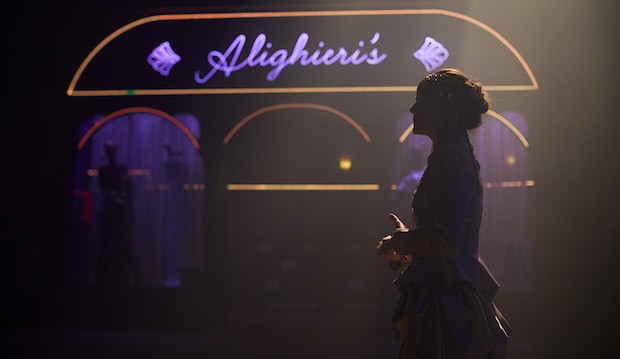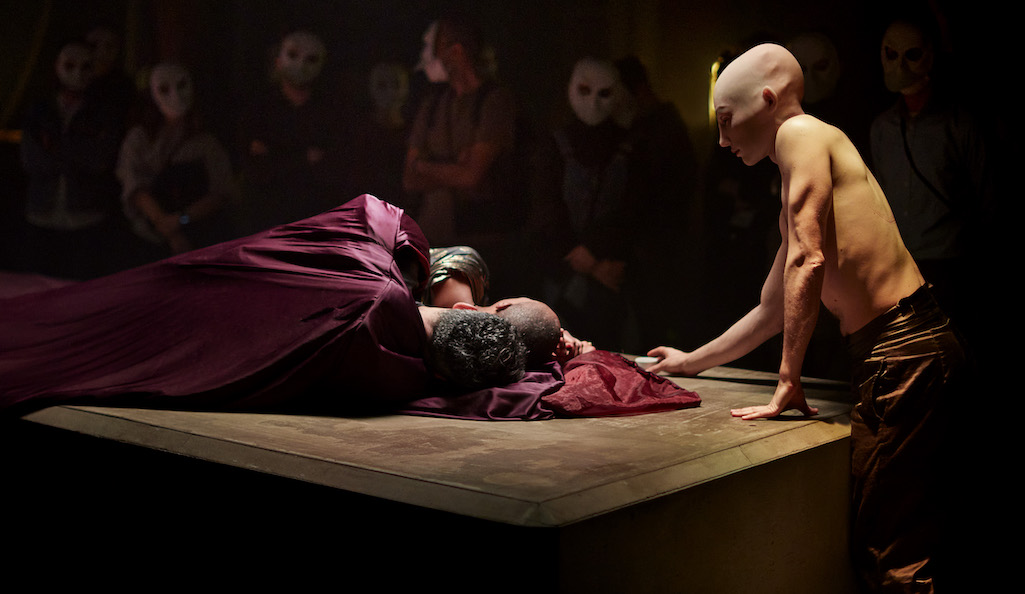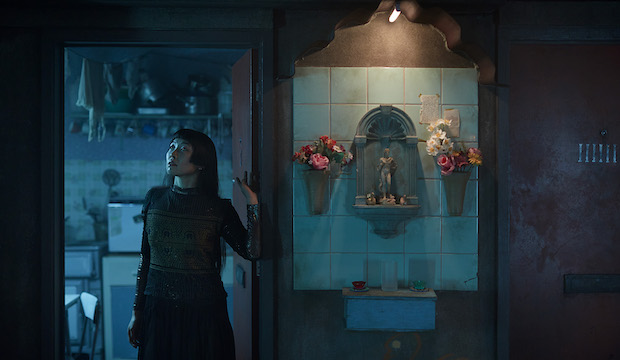Punchdrunk’s The Burnt City, Woolwich Works review ★★★★★
Punchdrunk's The Burnt City. Photo: Julian Abrams. Performers: Yilin Kong and Steven James Apicello
It’s been eight long years since pioneering immersive theatre troupe Punchdrunk last invited London audiences to roam around one of its choose-your-own-adventure productions. Since then, the company’s previous site-specific extravaganzas, including 2013’s Woyzeck-inspired The Drowned Man, 2007’s Edgar Allan Poe-fuelled The Masque Of The Red Death, and 2003’s Macbeth-inspired Sleep No More – which now has long-running revivals in New York and Shanghai – have become the stuff of theatre legend.
Click here to book
So it’s with a towering reputation (and sky-high expectations) that Punchdrunk has returned to London, making a cluster of Grade-II listed former military buildings in Woolwich its new headquarters and transforming two adjoining buildings into the 100,000 sq ft site of The Burnt City, a walk-through experience depicting the fall of Troy – a Troy that looks, in part, like a faded Vegas.

Emily Mytton in Punchdrunk's The Burnt City. Photo: Julian Abrams.
Artistic director Felix Barrett has called upon a team of his long-term collaborators including director and choreographer Maxine Doyle, and designers Livi Vaughan and Beatrice Minns, to create the show. Together, these founding figureheads of immersive theatre have created two worlds: one, a vast open space reflecting Greek Mycenae and the other, the labyrinth of Troy. Six hundred audience members, anonymised with compulsory white masks and admitted with staggered entry, are let loose in the theatrical playground each night, meeting up to 30 characters as they explore.
The first thing to know about The Burnt City is you can’t see it all. There’s no linear narrative to follow and audiences are encouraged to splinter, follow different characters and explore intricately detailed side rooms – a paper-strewn office, a child’s bedroom – on their own.
An initial chamber, posing as an exhibition on Troy, provides some context. Here, we learn of the two revenge-fuelled myths The Burnt City is primarily based upon: Aeschylus’ Agamemnon, whereby Clytemnestra murders her husband Agamemnon to avenge their daughter Iphigenia, who he sacrificed, and Euripides’ Hecuba, in which Hecuba blinds King Polymestor and kills his sons after he murders her youngest, Priam. Snippets from both are later enacted on a loop through ritualistic, interpretive dance, with bodies writhing and contorting in pain or embracing one another, overtaken by their emotions.

Vinicius Salles, Omagbitse Omagbemi and Andrea Carrucciu in Punchdrunk's The Burnt City. Photo: Julian Abrams.
The second thing to know about the show is it’s not worth getting bogged down in trying to rationalise sequences or decipher what it all means. The illusive, dialogue-free, fragmented nature of The Burnt City can leave you feeling like there’s a wider meaning hidden in a drawer somewhere or dangling just out of reach. Instead, embrace the sheer quirkiness of it.
The arena is impressively atmospheric and gets four of your five senses working (plus the fifth, taste, if you allow yourself a break in the bar, where cabaret performers provide some light relief from all the gore). In the airy, first world, dim lighting (courtesy of F9, Ben Donoghue and Barrett himself) and Stephen Dobbie’s soundscape of jarring, doom-filled drones add an inescapable feeling of tension. Underfoot, carpeted rooms bleed into soft, sandy outbacks, while on tables, a liberal spread of props can be pored over in the good faith that you won’t pocket a notebook, glass or creepy doll’s head as a keepsake.
Head through passport control, where beds are waiting for travellers whose documents can’t be processed, and a second, far more dense world of dark corridors and abandoned shops, lit by the glow of vending machines, retro arcade games and flickering neon signs, provides more opportunity for exploring solo, though at the expense of a coherent plot.

Yilin Kong in Punchdrunk's The Burnt City. Photo: Julian Abrams.
There’s no ‘right’ way of approaching The Burnt City. As Punchdrunk veterans will know, ‘fortune favours the brave’ in the sense that leaving the masses and following an individual character can reveal hidden pockets of action. But, there’s always the potential to be led astray or into a dead end. If you’re lucky, you might be chosen by a character and led into a secret area of the site. Do, at some point, leave the group, open a door or duck under a curtain, and explore a space alone.
The Burnt City culminates – and credit must go to the supporting staff for the slick operation of directing hundreds of roaming visitors back together – in two finales, one in each world. This reviewer found the ending in Troy anticlimactic, perhaps because they’d been too busy pondering a bed covered in toy owls to follow the build-up. Comparing notes afterwards, it sounded like a more moving final sequence was playing out over in Mycenae.
This dud note didn’t detract from the sprawling, all-encompassing mastery of the production, though. If anything, it’s made this reviewer resolve to return in the future and attempt to uncover further corners of The Burnt City.
Click here to book
So it’s with a towering reputation (and sky-high expectations) that Punchdrunk has returned to London, making a cluster of Grade-II listed former military buildings in Woolwich its new headquarters and transforming two adjoining buildings into the 100,000 sq ft site of The Burnt City, a walk-through experience depicting the fall of Troy – a Troy that looks, in part, like a faded Vegas.

Emily Mytton in Punchdrunk's The Burnt City. Photo: Julian Abrams.
Artistic director Felix Barrett has called upon a team of his long-term collaborators including director and choreographer Maxine Doyle, and designers Livi Vaughan and Beatrice Minns, to create the show. Together, these founding figureheads of immersive theatre have created two worlds: one, a vast open space reflecting Greek Mycenae and the other, the labyrinth of Troy. Six hundred audience members, anonymised with compulsory white masks and admitted with staggered entry, are let loose in the theatrical playground each night, meeting up to 30 characters as they explore.
The first thing to know about The Burnt City is you can’t see it all. There’s no linear narrative to follow and audiences are encouraged to splinter, follow different characters and explore intricately detailed side rooms – a paper-strewn office, a child’s bedroom – on their own.
An initial chamber, posing as an exhibition on Troy, provides some context. Here, we learn of the two revenge-fuelled myths The Burnt City is primarily based upon: Aeschylus’ Agamemnon, whereby Clytemnestra murders her husband Agamemnon to avenge their daughter Iphigenia, who he sacrificed, and Euripides’ Hecuba, in which Hecuba blinds King Polymestor and kills his sons after he murders her youngest, Priam. Snippets from both are later enacted on a loop through ritualistic, interpretive dance, with bodies writhing and contorting in pain or embracing one another, overtaken by their emotions.

Vinicius Salles, Omagbitse Omagbemi and Andrea Carrucciu in Punchdrunk's The Burnt City. Photo: Julian Abrams.
The second thing to know about the show is it’s not worth getting bogged down in trying to rationalise sequences or decipher what it all means. The illusive, dialogue-free, fragmented nature of The Burnt City can leave you feeling like there’s a wider meaning hidden in a drawer somewhere or dangling just out of reach. Instead, embrace the sheer quirkiness of it.
The arena is impressively atmospheric and gets four of your five senses working (plus the fifth, taste, if you allow yourself a break in the bar, where cabaret performers provide some light relief from all the gore). In the airy, first world, dim lighting (courtesy of F9, Ben Donoghue and Barrett himself) and Stephen Dobbie’s soundscape of jarring, doom-filled drones add an inescapable feeling of tension. Underfoot, carpeted rooms bleed into soft, sandy outbacks, while on tables, a liberal spread of props can be pored over in the good faith that you won’t pocket a notebook, glass or creepy doll’s head as a keepsake.
Head through passport control, where beds are waiting for travellers whose documents can’t be processed, and a second, far more dense world of dark corridors and abandoned shops, lit by the glow of vending machines, retro arcade games and flickering neon signs, provides more opportunity for exploring solo, though at the expense of a coherent plot.

Yilin Kong in Punchdrunk's The Burnt City. Photo: Julian Abrams.
There’s no ‘right’ way of approaching The Burnt City. As Punchdrunk veterans will know, ‘fortune favours the brave’ in the sense that leaving the masses and following an individual character can reveal hidden pockets of action. But, there’s always the potential to be led astray or into a dead end. If you’re lucky, you might be chosen by a character and led into a secret area of the site. Do, at some point, leave the group, open a door or duck under a curtain, and explore a space alone.
The Burnt City culminates – and credit must go to the supporting staff for the slick operation of directing hundreds of roaming visitors back together – in two finales, one in each world. This reviewer found the ending in Troy anticlimactic, perhaps because they’d been too busy pondering a bed covered in toy owls to follow the build-up. Comparing notes afterwards, it sounded like a more moving final sequence was playing out over in Mycenae.
This dud note didn’t detract from the sprawling, all-encompassing mastery of the production, though. If anything, it’s made this reviewer resolve to return in the future and attempt to uncover further corners of The Burnt City.
TRY CULTURE WHISPER
Receive free tickets & insider tips to unlock the best of London — direct to your inbox
| What | Punchdrunk’s The Burnt City, Woolwich Works review |
| Where | Woolwich Works , The Fireworks Factory, 11 No 1 St, Royal Arsenal, London , SE18 6HD | MAP |
| Nearest tube | Woolwich Arsenal (underground) |
| When |
22 Mar 22 – 23 Sep 23, 6:30 PM – 9:30 PM |
| Price | £25+ |
| Website | Click here for more information and to book |